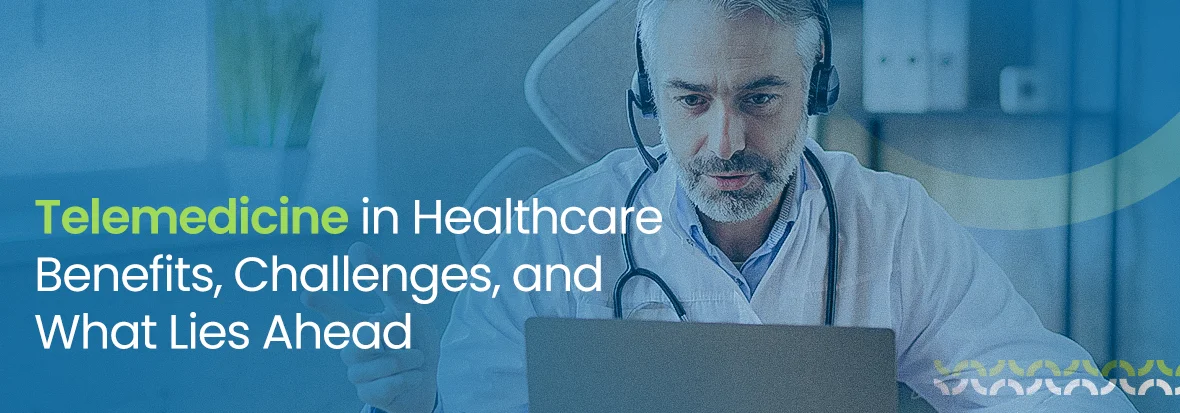Technological advancements have transformed various aspects of our lives in ways we could never have imagined. In healthcare, for instance, these innovations have enabled medical specialties to extend their reach to regions that previously lacked access, making care more accessible to patients in need.
Through telemedicine, physicians across different fields can provide treatment to patients regardless of where they are located. This approach gives patients the flexibility to schedule and access healthcare on their terms, without the hassle of traveling long distances. It puts them in control, helping them make more informed decisions about their health and overall well-being.
In this blog, we will thoroughly analyze what telemedicine is, its applications, limitations, and the future it holds. So, without any further ado, let’s dive into the details.
What is Telemedicine?
Although “telemedicine” and “telehealth” are often treated as synonyms, they have distinct meanings. Telemedicine specifically refers to providing healthcare services and sharing clinical information remotely through telecommunications technologies. This can involve various clinical services delivered via the internet, wireless networks, satellites, or phones.
Telehealth, on the other hand, covers a wider range of services, such as diagnosis, patient management, education, and other healthcare activities. It’s important to keep in mind that the definitions of telehealth and telemedicine can differ from state to state, depending on specific regulations.
Why Does the Healthcare System Need Telemedicine?
Rising healthcare costs and the demand for better care are pushing hospitals to explore telemedicine. This technology improves communication between doctors and patients in remote areas while making better use of healthcare resources. It also supports stronger connections, leading to fewer hospital readmissions and better patient adherence to prescribed treatments.
Telemedicine enhances communication not just between doctors and patients but also among healthcare professionals. It allows doctors to collaborate, share expertise, and provide improved care. Delivered online, often via video chats, telemedicine offers significant benefits to both patients and providers. Despite some technical challenges and skepticism, it has the potential to complement and improve the overall patient experience.
Telemedicine Applications Areas for The Healthcare Sector
| S. No. | Applications | Description |
|---|---|---|
| 1 | Telehealth | Enables clinicians, researchers, and doctors to provide care remotely using devices like computers and high-resolution cameras. |
| 2 | Services for Disabled Patients | Improves healthcare access for disabled, elderly, isolated, or incarcerated patients, reducing hospital visits and saving costs. |
| 3 | Remote Treatment | Allows patients to consult specialists from home, reducing travel and enabling collaborative care among providers. |
| 4 | School Children’s Care | Offers quick diagnosis via video consultations in schools, reducing unnecessary clinic visits and providing timely guidance. |
| 5 | Non-Lab Conditions | Suitable for disorders not requiring lab tests, such as psychotherapy or remote prescription of medications. |
| 6 | Virtual Doctor Appointments | Facilitates remote consultations, improving patient quality of life and reducing healthcare costs. |
| 7 | System Performance Enhancement | Supports clinical and non-clinical services, including chronic care, expert consultations, and administrative tasks, through secure remote access. |
| 8 | Improved Patient Coordination | Reduces fragmented care, travel costs, and absences from work, while enhancing communication between patients and doctors. |
| 9 | Reduced Patient Travel | Minimizes travel and waiting time by enabling online appointments and virtual consultations from home. |
| 10 | Teledentistry | Allows dentists to share records and consult specialists remotely, improving access for underserved areas. |
| 11 | Clinician & Patient Benefits | Addresses healthcare provider shortages and enhances private practices with video conferencing solutions. |
| 12 | Digital Health Monitoring | Uses AI and telemedicine tools to improve diagnoses, monitoring vitals like blood pressure and glucose remotely. |
| 13 | Skincare | Facilitates remote consultations for dermatological conditions using high-resolution images, improving access for homebound patients. |
| 14 | Medication Tracking | Monitors medication intake and health metrics remotely, benefiting older adults and those with chronic conditions. |
| 15 | Infection Prevention | Reduces exposure to contagious diseases by enabling virtual consultations and secure data sharing. |
| 16 | Cost-Effectiveness | Saves costs on travel, infrastructure, and consultations while expanding healthcare access and training opportunities. |
| 17 | Reduce Face to Face Meeting | Telemedicine reduces in-person visits by allowing remote patient monitoring and easing ER overcrowding. It also speeds up care delivery and lowers health risks through virtual supervision. |
Limitations of Telemedicine in Healthcare
Telemedicine has several limitations compared to traditional healthcare methods. While it complements the healthcare system, it cannot fully replace in-person care. One significant concern is the risk of patient medical data being hacked, especially when accessed through public networks or unsecured channels. Additionally, telemedicine is not ideal for emergencies, as doctors cannot provide life-saving treatments or conduct laboratory tests remotely, potentially delaying critical care.
State regulations also pose challenges, as physicians may be restricted from practicing across state lines depending on licensing rules. Providers must ensure that their telemedicine platforms comply with privacy laws and maintain high standards of security.
Need help billing for telemedicine services?
During telemedicine consultations, clinicians rely heavily on patient self-reports, which can lead to incomplete diagnoses if patients fail to mention key symptoms that might have been noticed during an in-person visit. Cost and accessibility are other significant drawbacks. Setting up and maintaining telemedicine infrastructure can be expensive, making it less feasible for smaller healthcare providers. Lastly, poor communication, whether due to technical issues or a lack of personal connection, can impact the quality of care delivered. Here are some of the prominent challenges of telemedicine in healthcare:

- Privacy and Security Concerns: Telemedicine requires the sharing of sensitive health data. If security systems are not strong enough, there’s a risk of data breaches. For instance, hackers could potentially access a patient’s medical records during an online consultation.
- Regulatory Issues: Different states or countries have their own rules regarding telemedicine. This can create confusion for healthcare providers about what’s legal or not. For example, a doctor licensed in one state might not be able to treat a patient from another state due to these regulations.
- Lack of Physical Examination: Some health conditions require hands-on examination for an accurate diagnosis. In telemedicine, this can be difficult, as doctors can only rely on what the patient tells them. For instance, a doctor might not be able to properly assess a physical injury like a sprained ankle during a video call.
- Patient Engagement: Some patients might feel less comfortable using telemedicine or may not engage as actively as they would during an in-person visit. Older adults, for example, may find it challenging to manage telemedicine platforms or feel disconnected without face-to-face interaction.
Technology glitches are another challenge in telemedicine. These can include:
- Poor Audio or Video Quality: During virtual consultations, poor sound or blurry visuals can make it hard for both the doctor and patient to communicate clearly. For instance, a patient might have difficulty explaining their symptoms if the video freezes or the audio cuts out.
- Technology Barriers: Not all patients have access to the technology needed for telemedicine, like reliable internet or a smartphone. For example, in rural areas, patients may struggle to connect to virtual appointments because of poor internet connectivity.
- Software Problems: Sometimes the telemedicine platform itself may not work as expected, like freezing or crashing during a session. This can delay appointments or make it impossible to complete a consultation.
- Compatibility Issues: Not all devices or operating systems work well with telemedicine platforms. For example, a patient using an older smartphone may struggle to join a video call because their device isn’t compatible with the software.
The Future of Telemedicine in Healthcare
In the future, patients will easily book appointments with their preferred doctors through a simple registration process. They will upload medical history, verification documents, reports, and prescriptions rather than typing everything out. The patient interface will help doctors create urgent care plans by providing a comprehensive view of the patient’s physical and personal records, aiding decision-making.
Local healthcare resources will be efficiently mobilized to handle both emergency and non-emergency services, allowing doctors to focus on more complex cases in person. Emergency departments may use video consultations to triage patients, enabling quicker discharge of non-urgent cases and improving overall patient care.
Healthcare organizations are increasingly adopting telemedicine software, which has connected cardiologists with patients in rural areas and streamlined follow-up appointments. Remote patient management is becoming a key focus for virtual healthcare, creating new opportunities for businesses to address this growing need.
So, we can say that the future of telemedicine in healthcare is bright, with many exciting developments ahead. Let’s examine some key trends:
- Integration of Artificial Intelligence (AI): AI is enhancing telemedicine by improving diagnostic accuracy and personalizing patient care. For example, AI algorithms can analyze medical images to detect conditions like tumors, aiding in early diagnosis. Additionally, AI-powered chatbots are being developed to provide immediate responses to patient inquiries, streamlining communication.
- Expansion of Digital Therapeutics: Digital therapeutics (DTx) are gaining traction as clinically validated software applications that deliver therapeutic interventions. These tools offer personalized treatments for various conditions, including mental health disorders and chronic diseases, directly through patients’ devices. For instance, AI-driven physiotherapy apps are being trialed to assist patients with back pain, reducing NHS waiting times.
- Enhanced Remote Monitoring: Advancements in wearable devices and remote monitoring tools enable continuous tracking of patients’ health metrics. This technology is particularly beneficial for managing chronic conditions, allowing healthcare providers to make timely interventions based on real-time data. Studies indicate that remote monitoring can lead to better health outcomes and reduced hospital readmissions.
- Policy and Regulatory Developments: Research is focusing on understanding the adoption of telemedicine, identifying gaps, and proposing future directions. This includes examining the impact of policy reforms on telemedicine usage and exploring strategies to overcome barriers to its implementation. Such studies are crucial for developing frameworks that support the sustainable integration of telemedicine into healthcare systems.
- Addressing Technological Challenges: Ongoing research aims to overcome technological barriers in telemedicine, such as network capacity and data management. Innovations like software-defined networks (SDN) and unmanned aerial vehicles (UAVs) are being explored to enhance the delivery of telemedicine services, especially in remote areas.
- Global Reach: Telemedicine will expand worldwide, providing healthcare in underserved regions and opening up opportunities for global health collaborations.
- Mental Health: Telemedicine will continue to support mental health services, offering patients easy access to therapy and counseling.
In short, telemedicine is set to transform healthcare by making it more accessible, efficient, and personalized for both patients and providers.
Optimize your practice for virtual care success
Final Verdict
Telemedicine plays a crucial role in connecting healthcare providers with patients, supporting long-term lifestyle changes. It offers significant benefits for medical office staff by reducing the burden of patient check-ins and allowing them to focus on more important tasks. With online consultations, doctors can care for patients while also assisting other practices.
Telemedicine removes geographic barriers by enabling the exchange of diagnoses, care plans, and disease prevention advice between patients and doctors through electronic communication. It is particularly beneficial for individuals in rural areas where quality healthcare may not be easily accessible.
In recent years, telemedicine has improved healthcare quality by enabling information sharing across distant locations, increasing access to underserved areas, and making it easier for patients to schedule appointments. People with limited mobility can receive medical advice and prescriptions quickly, without the need for travel. Telemedicine reduces the need for both doctors’ and patients’ travel, improving healthcare delivery and ensuring that patients receive the necessary treatment.
Reference:

